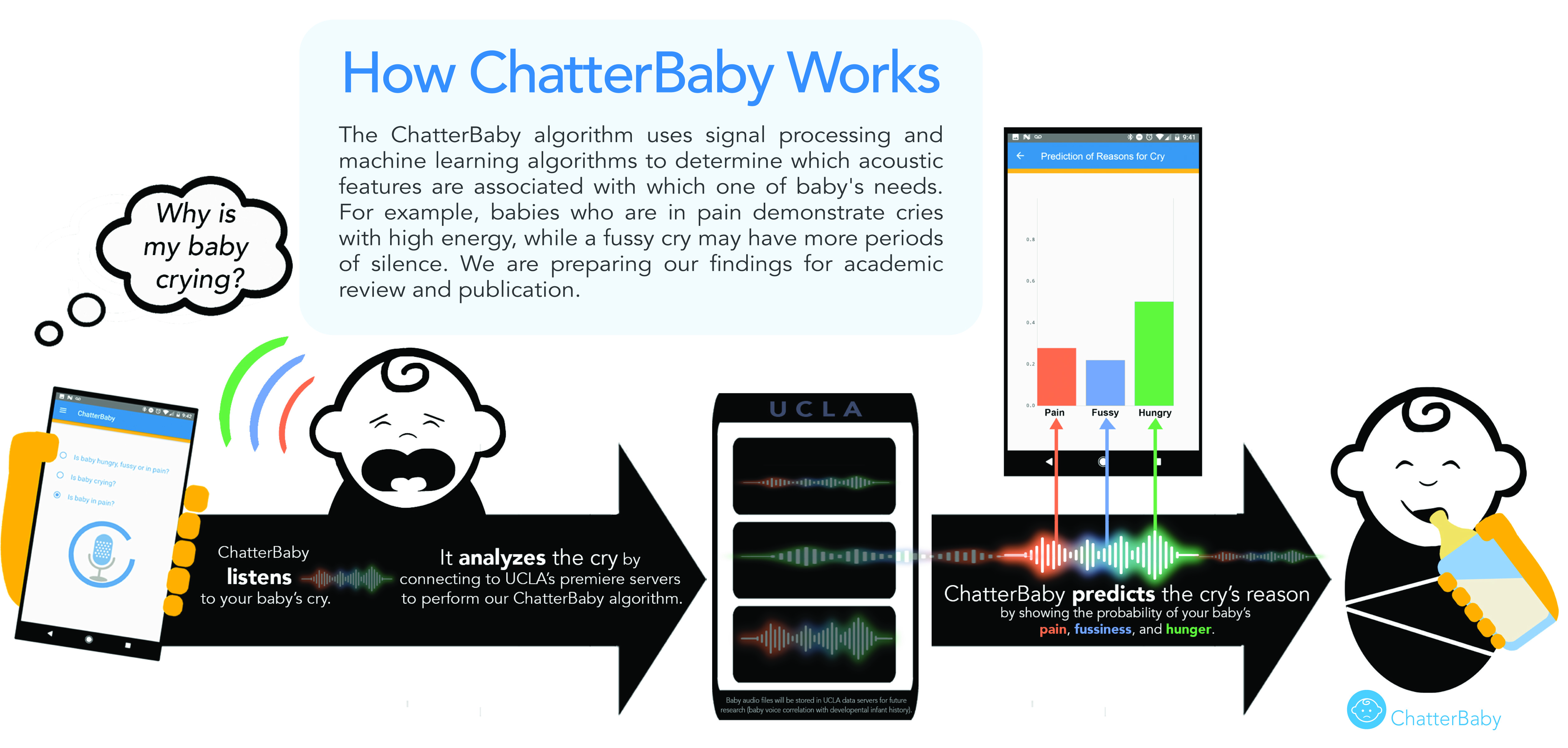Frequently Asked Questions
ChatterBaby™ is an algorithm that helps you determine why your baby is crying, by translating your baby’s cry into a need. It works by analyzing the specific acoustic features of your baby’s cry and then comparing them with pre-labeled cries in our infant sound database. The infant cries are translated using artificial intelligence and machine learning techniques.
Please note that once you begin using the app to quickly and easily solve the “why won’t the baby stop crying” dilemma, perhaps even gaining the reputation of ‘baby whisperer,’ we strongly suggest that you reach out and apologize to any math teacher in your life who has ever been asked “Why do I even need to learn this?!”

Using machine learning and artificial intelligence, it will translate your baby’s cry into one of three needs: fussy, hungry, or pain. If your baby is crying because he really, really, wants to eat some Legos and you just won’t let him (true story), it will not work.
We are currently adding other states such as colic, gassy, dirty diaper, tired, scared, and bored, once we have enough evidence to show these states are reliably different. DONATE DATA You can donate cry data (button below) as video or audio files, to personalize the algorithm to your baby and increase the number of cry “words” in our vocabulary. Donating data will help “tune” the algorithm and increase the accuracy when it hears your baby’s unique voice. Sad fact: most colic cries are predicted as "pain" by our algorithm.
When the algorithm’s predictions are closely tied, always consider the second-place choice as well. When using the algorithm to analyze a sound clip, you should use data with minimal background noise, and then apply your own judgment. If you feed ChatterBaby a sound clip of you singing to your crying infant, it will not work. If you feed ChatterBaby a sound clip of your dog barking, it will not work.
You can increase the accuracy of ChatterBaby by labeling the data in our app after we give our prediction: Select "Teach ChatterBaby About Your Baby" to translate your baby’s cry into many possible needs, including ear-infection, tired, and separation anxiety. You can also increase the accuracy of ChatterBaby by donating video or audio data to our study here through our website here: DONATE DATA
You can trust ChatterBaby to translate ~90% of the time whether your baby’s reason for crying is because she is experiencing some degree of acute pain. Certain “Pain” cries usually have very high Pain ratings (>80%). However, your parental instincts and intuition are far more powerful than our most sophisticated equations. If the ChatterBaby translation and your common sense disagree, always trust your own judgment.

ChatterBaby can only tell you if your baby is crying because she’s likely in acute pain – it cannot provide any insight into whether your baby is healthy or sick, whether it’s an emergency or not, or whether you should call your doctor even though it’s 3AM. Our algorithm never made it into medical school, but your doctor thankfully did! So if you think your baby is sick, always call your doctor (yes, even at 3AM)! ChatterBaby is not meant to be used as a substitute for appropriate medical care.
The ChatterBaby algorithm can actually be personalized specifically for your baby! Within the app, select "Teach ChatterBaby About Your Baby" to label your baby’s cry for us- what does your intuition say the cry reason is? By sending us audio or video clips of your baby crying along with a description of why (e.g. he’s hungry vs. he just got his vaccines vs. his big brother scared him by wearing a clown mask), we can “teach” the algorithm the unique nuances of your baby’s cry and optimize its predictive accuracy.
If you’re interested in a personalized ChatterBaby for your infant, you can also donate your baby’s video or audio recordings online through Donation Form. Remember, the more audio data you provide, the more fine-tuning we can do!
DONATE DATA
Sending data assumes you consent to our research study participation described here in our Consent Form and our Privacy Policy.. After we generate your personalized ChatterBaby™, we ask that you donate your labeled audio samples for use in our growing \ database. Please be assured that we take your privacy very seriously –all samples are scrubbed of any identifying and rendered completely anonymous.
Anytime you predict using ChatterBaby, you are sending your audio data to UCLA along with any other data you provide (baby’s age, etc.) and are consenting to be in our research study. We store it for science on a server that is HIPAA-compliant; the data is “de-identified,” which means that we remove information that links your data to you individually.
In addition to creating a “Rosetta Stone” for baby cries, we are interested in discovering whether abnormal vocalization patterns in infants can predict neurodevelopmental disorders such as autism spectrum disorder. In order to do so, we need to analyze thousands of audio samples from thousands of babies using math(emagics). For more information, please refer to the Consent Form and our privacy policy that you acknowledged and accepted when launching the app via our Consent Form and our Privacy Policy
Nope. Nein. Zero. Zilch. Nada.
No. See also "Can I trust the ChatterBaby™ algorithm?" above.
Please contact ChatterBaby's founder, Dr. Ariana Anderson, at arianaanderson@mednet.ucla.edu. Please also visit ChatterBaby.org for a complete list of credits to whom ChatterBaby is indebted, as well as project updates, contact information, and lots more!






